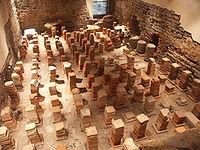Throughout history, the ever present, natural principles of sustainable building have been utilized in varying ways. What our ancestors practiced in building design for generations upon generations, we now call Annualized Geo Solar – a structural-heating technique combining summertime capture of solar warmth, deposit and storage of that heat in insulation-buffered sub-structure soil, and, after a designed-in conductive thermal lag, radiational return of a portion of the warmth from the surface of a conductive floor, to (usually passively) heat the living space – and Thermal Diffusivity – the measure of how rapidly a substance adjusts their temperature to that of their surroundings, in comparison to their volumetric heat capacity or ‘thermal mass‘.
Take for example the Hogan of the N avajo People of North America. Framed out of wood logs and covered in earth, the Hogan is the Navajo People’s ancestral dwelling. It was round, with the door facing east. The packed earth created thermal mass that was then warmed by the inner fire. As the earth warmed, it radiated heat back into the dwelling and kept the winter winds at bay. In the summer, the earth’s ambient cooler temperatures radiated up from the ground and cooled the dwelling.
avajo People of North America. Framed out of wood logs and covered in earth, the Hogan is the Navajo People’s ancestral dwelling. It was round, with the door facing east. The packed earth created thermal mass that was then warmed by the inner fire. As the earth warmed, it radiated heat back into the dwelling and kept the winter winds at bay. In the summer, the earth’s ambient cooler temperatures radiated up from the ground and cooled the dwelling.
 Native Americans, such as the Navajo and Pueblo People, weren’t the only civilizations to incorporate thermal mass principles for heating and cooling their buildings. As early as 25 BC, the Romans began building hypocausts – an ancient Roman system of central heating. Due to the expense, hypocausts were usually only for heating public baths and wealthy, private residents.
Native Americans, such as the Navajo and Pueblo People, weren’t the only civilizations to incorporate thermal mass principles for heating and cooling their buildings. As early as 25 BC, the Romans began building hypocausts – an ancient Roman system of central heating. Due to the expense, hypocausts were usually only for heating public baths and wealthy, private residents.
 A hypocaust was built by raising the floor on stacks of clay pillars, leaving air channels under the floor; and putting clay box tiles in the walls. These channels allowed hot air and smoke to pass through the floor and vent up the walls, heating the tiles and the walls, and then venting out a chimney. This created a natural convection that heated the living space by radiated heat; while keeping the air free of smoke. In ancient times, heating the air was primarily done by a fireplace.
A hypocaust was built by raising the floor on stacks of clay pillars, leaving air channels under the floor; and putting clay box tiles in the walls. These channels allowed hot air and smoke to pass through the floor and vent up the walls, heating the tiles and the walls, and then venting out a chimney. This created a natural convection that heated the living space by radiated heat; while keeping the air free of smoke. In ancient times, heating the air was primarily done by a fireplace.
In modern American building, we see very few builders incorporating these age old principles in building design. Why? In my next entry, I’ll analyze this key question.
